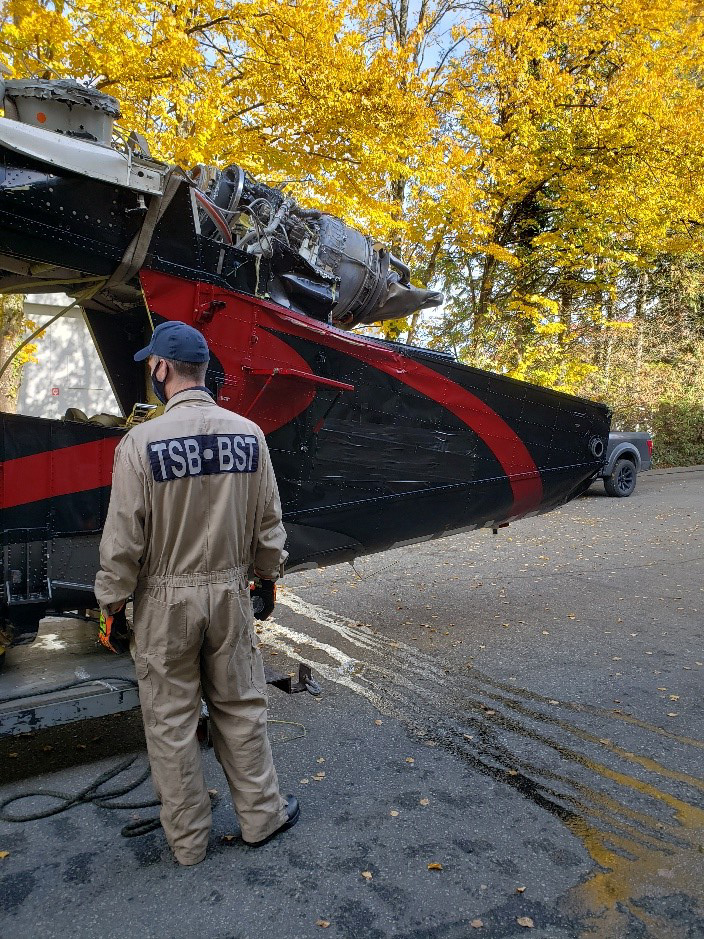Air transportation safety investigation A21P0107
Updated in July 2023: This investigation is in the report phase.
Table of contents
Collision with water
Black Tusk Helicopters Inc.
Kaman K-MAX (K-1200)
Killam Bay, British Columbia
The occurrence
On , a Kaman K-MAX (K-1200) helicopter operated by Black Tusk Helicopters Inc., was conducting helicopter logging operations in the vicinity of Killam Bay, British Columbia (BC). The helicopter was transporting logs from a cut block to an ocean pen approximately 0.6 nautical miles to the northwest. About 1 minute after the helicopter departed the cut block, a loud noise was heard by the cut block workers coming from the area of the ocean pen. A company support helicopter was sent to search the area of the ocean pen since the pilot could not be contacted by radio and did not return to the cut block. The support helicopter found debris in the water and a sheen on the water. A search and rescue effort was launched but was unable to locate the helicopter. Portions of the rotor blades were recovered by searchers. The helicopter was located 8 days after the occurrence approximately 150 m west of the initial collision with water, and at a depth of approximately 110 m. The pilot, who was the only person on board, was fatally injured.
On 18 October 2021, TSB investigators linked up with the RCMP Sechelt, BC, detachment and travelled to the accident site. The helicopter was raised onto a barge while the TSB investigators oversaw and documented the process before removing critical pieces from the instrument panel.
On 19 October 2021, two investigators met the barge and oversaw the transshipment of the wreckage to a tractor trailer, which brought it to the TSB wreckage examination facility. The TSB is investigating.
Media materials
Deployment notice
TSB deploys an investigator to Nanaimo, BC, following helicopter accident in Jervis Inlet, BC
Richmond, BC, 5 October 2021 — The Transportation Safety Board of Canada (TSB) has deployed an investigator to Nanaimo, BC, following yesterday’s accident involving a Kaman KMax helicopter in Jervis Inlet, BC. The TSB will gather information and assess the occurrence.
Investigation information
Map showing the location of the occurrence
Investigator-in-charge

Ryan Libech joined the TSB’s Air Investigations Branch in 2020 after having spent 18 years in private sector helicopter maintenance and production management, notably working on BK117, Airbus EC120/130, Bell 206/407, and Agusta A109 helicopters, in emergency medical service, private and utility environments. He was also a maintenance lead for international helicopter deployment in the Middle East, and worked periodically as an instructor for professional maintenance training. The majority of his expertise is in aircraft maintenance and operations. Mr. Libech has a diploma in aircraft maintenance engineers technology from the Southern Alberta Institute of Technology (SAIT) in Calgary, Alberta.
Photos
Class of investigation
This is a class 2 investigation. These investigations are complex and involve several safety issues requiring in-depth analysis. Class 2 investigations, which frequently result in recommendations, are generally completed within 600 days. For more information, see the Policy on Occurrence Classification.
TSB investigation process
There are 3 phases to a TSB investigation
- Field phase: a team of investigators examines the occurrence site and wreckage, interviews witnesses and collects pertinent information.
- Examination and analysis phase: the TSB reviews pertinent records, tests components of the wreckage in the lab, determines the sequence of events and identifies safety deficiencies. When safety deficiencies are suspected or confirmed, the TSB advises the appropriate authority without waiting until publication of the final report.
- Report phase: a confidential draft report is approved by the Board and sent to persons and corporations who are directly concerned by the report. They then have the opportunity to dispute or correct information they believe to be incorrect. The Board considers all representations before approving the final report, which is subsequently released to the public.
For more information, see our Investigation process page.
The TSB is an independent agency that investigates air, marine, pipeline, and rail transportation occurrences. Its sole aim is the advancement of transportation safety. It is not the function of the Board to assign fault or determine civil or criminal liability.
